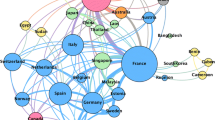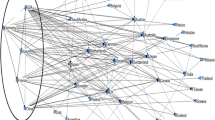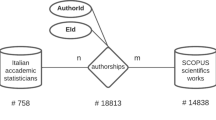Abstract
In this exploratory study, we analyze co-authorship networks of collaborative cancer research in India. The complete network is constructed from bibliometric data on published scholarly articles indexed in two well-known electronic databases covering two 6-year windows from 2000 to 2005 and 2006 to 2011 inclusive. Employing a number of important metrics pertaining to the underlying topological structures of the network, we discusses implications for effective policies to enhance knowledge generation and sharing in cancer research in the country. With some modifications, our methods can be applied without difficulty to examine policy structure of related disciplines in other countries of the world.
















Similar content being viewed by others
Notes
The holes are more accurately identified by considering densities and constraints in ego networks of the individual researchers in the complete network.
References
Acedo, F. J., Barroso, C., Casanueva, C., & Galán, J. L. (2006). Co-authorship in management and organizational Studies: An empirical and network analysis. Journal of Management Studies, 43(4), 957–983.
Albert, R., & Barabási, A.-L. (2002). Statistical mechanics of complex networks. Reviews of Modern Physics, 74(1), 47–97.
Barabási, A.-L., Jeong, H., Ravasz, R., Néda, Z., Vicsek, T., & Schubert, A. (2002). On the topology of the scientific collaboration networks. Physica, 311, 590–614.
Batagelj, V., Mrvar, A., & Zaveršnik, M. (2012). Obtained from http://pajek.imfm.si/doku.php. Accessed 2 Jan 2014.
Bozeman, B., & Corley, E. (2004). Scientists’ collaboration strategies: Implications for scientific and technical human capital. Research Policy, 33(4), 599–616.
Burt, R. S. (2004). Structural holes and good ideas. American Journal of Sociology, 110(2), 349–399.
Eckhouse, S., Lewison, G., & Sullivan, R. (2008). Trends in the global funding and activity of cancer research. Molecular Oncology, 2(1), 20–32.
Ghosh, J., & Kshitij, A. (2014). An integrated examination of collaboration co-authorship networks through structural cohesion, holes, hierarchy, and percolating clusters. Journal of the American Society for Information Science and Technology. Early view http://onlinelibrary.wiley.com/doi/10.1002/asi.23058/abstract. doi:10.1002/asi.23058. Accessed 3 April 2014.
Granovetter, M. S. (1973). The strength of weak ties. American Journal of Sociology, 78(6), 1360–1380.
Hara, N., Solomon, P., Kim, S.-L., & Sonnenwald, D. H. (2003). An emerging view of scientific collaboration: Scientists’ perspectives on collaboration and factors that impact collaboration. Journal of the American Society for Information Science and Technology, 54(10), 952–965.
Hofstede, G. (1983). National culture in four dimensions: A research-based theory of cultural differences among nations. International Studies of Management and Organization, 13(1–2), 46–74.
Lewison, G., Purushotham, A., Mason, M., McVie, G., & Sullivan, R. (2010). Understanding the impact of public policy on cancer research: A bibliometric approach. European Journal of Cancer, 46(5), 912–919.
Leydesdorff, L., & Wagner, C. S. (2008). International collaboration in science and the formation of a core group. Journal of Informetrics, 2(4), 317–332.
Lotka, A. J. (1926). The frequency distribution of scientific productivity. Journal of the Washington Academy of Science, 16(2), 317–323.
Melin, G., & Persson, O. (1996). Studying research collaboration through co-authorships. Scientometrics, 36(3), 363–377.
Milgram, S. (1967). The small-world problem. Psychology Today, 1(1), 61–67.
Milojević, S. (2013). Accuracy of simple, initials-based methods for author name disambiguation. Journal of Informetrics, 7(4), 767–773.
Newman, M. E. J. (2001a). The structure of scientific collaboration networks. Proceedings of the National Academy of Sciences, 98(2), 404–409.
Newman, M. E. J. (2001b). Scientific collaboration networks. I. Network construction and fundamental results. Physical Review E, 64 (016131), 016131-1–016131-8.
Newman, M. E. J. (2003). The structure and function of complex networks. SIAM Review, 45(2), 167–256.
Scott, J. (2000). Social network analysis: A handbook. London: Sage Publications.
Shrum, W., Genuth, J., & Chompalov, I. (2007). Structures of scientific collaboration. Cambridge, Massachusetts: MIT Press.
Wasserman, S., & Faust, K. (1994). Social network analysis. Cambridge, UK: Cambridge University Press.
Watts, D. J., & Strogatz, S. H. (1998). Collective dynamics of ‘small-world’ networks. Nature, 393, 440–442.
Acknowledgments
The authors wish to acknowledge two anonymous reviewers of Scientometrics for suggesting a few improvements in the paper. Thanks are also due to Dr. P. Banerjee, Director of CSIR – NISTADS, for helpful comments on an early version of the paper. Jaideep Ghosh would like to thank the Department of Science & Technology, Government of India, for financial support to carry out this work.
Author information
Authors and Affiliations
Corresponding author
Rights and permissions
About this article
Cite this article
Kshitij, A., Ghosh, J. & Gupta, B.M. Embedded information structures and functions of co-authorship networks: evidence from cancer research collaboration in India. Scientometrics 102, 285–306 (2015). https://doi.org/10.1007/s11192-014-1310-y
Received:
Published:
Issue Date:
DOI: https://doi.org/10.1007/s11192-014-1310-y




